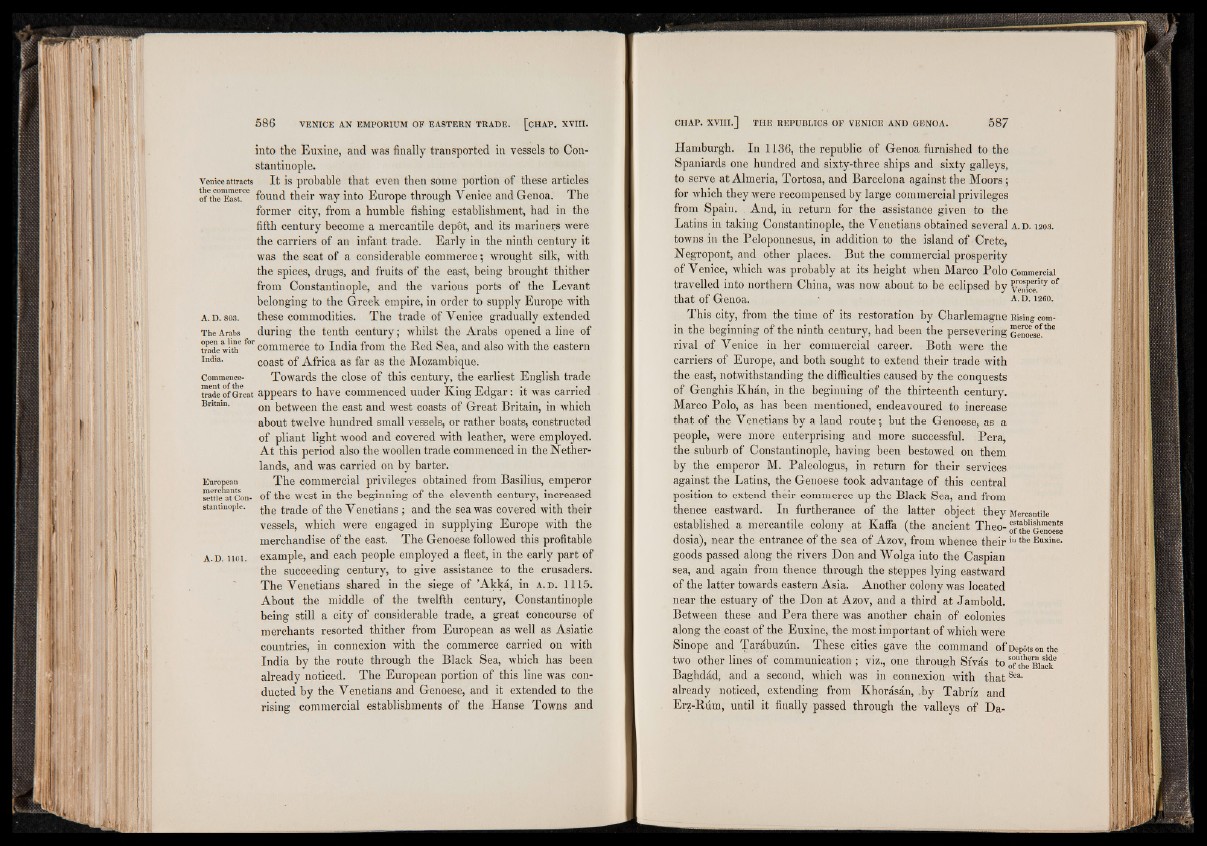
into the Euxine, and was finally transported in vessels to Constantinople.
Venice attracts It is probable that even then some portion of these articles
onheE™siTe found their way into Europe through Venice and Genoa. The
former city, from a humble fishing establishment, had in the
fifth century become a mercantile depot, and its mariners were
the carriers of an infant trade. Early in the ninth century it
was the seat of a considerable commerce; wrought silk, with
the spices, drugs, and fruits of the east, being brought thither
from Constantinople, and the various ports of the Levant
belonging to the Greek empire, in order to supply Europe with
a . d . 803. these commodities. The trade of Venice gradually extended
The Arabs during the tenth century; whilst the Arabs opened a line of
trade wi&e "* commerce to India from the Red Sea, and also with the eastern
indra. coast of Africa as far as the Mozambique.
Commence- Towards the close of this century, the earliest English trade
trade of Great appears to have commenced under King Edgar: it was carried
Britain. 0I1 between the east and west coasts of Great Britain, in which
about twelve hundred small vessels, or rather boats, constructed
of pliant light wood and covered with leather, were employed.
At this period also the woollen trade commenced in the Netherlands,
and was carried on by barter.
European The commercial privileges obtained from Basilius, emperor
™tt'iehatCon- of the west in the beginning of the eleventh century, increased
stantmopie. trade of the Venetians ; and the sea was covered with their
vessels, which were engaged in supplying Europe with the
merchandise of the east. The Genoese followed this profitable
a . d . 1101. example, and each people employed a fleet, in the early part of
the succeeding century, to give assistance to the crusaders.
The Venetians shared in the siege of ’Akka, in a . d . 1115.
About the middle of the twelfth century, Constantinople
being still a city of considerable trade, a great concourse of
merchants resorted thither from European as well as Asiatic
countries, in connexion with the commerce carried on with
India by the route through the Black Sea, which has been
already noticed. The European portion of this line was conducted
by the Venetians and Genoese, and it extended to the
rising commercial establishments of the Hanse Towns and
Hamburgh. In 1136, the republic of Genoa furnished to the
Spaniards one hundred and sixty-three ships and sixty galleys,
to serve at Almeria, Tortosa, and Barcelona against the Moors;
for which they were recompensed by large commercial privileges
from Spain. And, in return for the assistance given to the
Latins in taking Constantinople, the Venetians obtained several a . d . 1203 .
towns in the Peloponnesus, in addition to the island of Crete,
Negropont, and other places. But the commercial prosperity
of Venice, which was probably at its height when Marco Polo Commercial
travelled into northern China, was now about to be eclipsed by Venice^ °f
that of Genoa. ‘ A- d . 12 60 .
This city, from the time of its restoration by Charlemagne Rising com-
in the beginning of the ninth century, had been the persevering Q^“ °efthe
rival of Venice in her commercial career. Both were the
carriers of Europe, and both sought to extend their trade with
the east, notwithstanding the difficulties caused by the conquests
of Genghis Khan, in the beginning of the thirteenth century.
Marco Polo, as has been mentioned, endeavoured to increase
that of the Venetians by a land route; but the Genoese, as a
people, were more enterprising and more successful. Pera,
the suburb of Constantinople, having been bestowed on them
by the emperor M. Paleologus, in return for their services
against the Latins, the Genoese took advantage of this central
position to extend their commerce up the Black Sea, and from
thence eastward. In furtherance of the latter object they Mercantile
established a mercantile colony at Kaffa (the ancient Theo- on^e’cenoese
dosia), near the entrance of the sea of Azov, from whence theirin the Enxine-
goods passed along the rivers Don and Wolga into the Caspian
sea, and again from thence through the steppes lying eastward
of the latter towards eastern Asia. Another colony was located
near the estuary of the Don at Azov, and a third at Jambold.
Between these and Pera there was another chain of colonies
along the coast of the Euxine, the most important of which were
Sinope and Tarabuzun. These cities gave the command of Depots on the
two other lines of communication ; viz., one through Sivas to ofThe Black6
Baghdad, and a second, which was in connexion with that8“ -
already noticed, extending from Khorasan, .by Tabriz and
Erz-Bdm, until it finally passed through the valleys of Da